| 1971 Plymouth Fury |
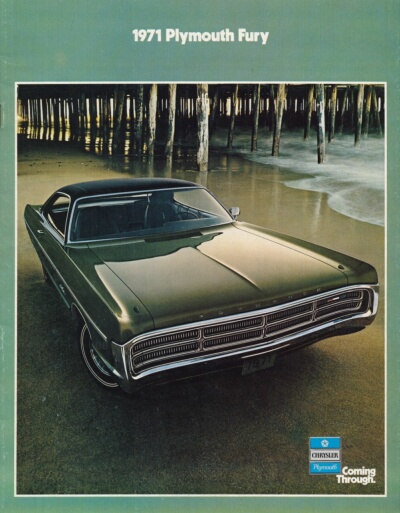 Click cover to browse the entire catalog Do you want to see a larger version of the cover? |
|
The Plymouth full-size models were going into their third year in 1971. The grilles and lights were rearranged some, but no major metal was moved. New were rectangular outside rearview mirrors. The grille now had a recessed horizontal division. The Sport Fury again sported concealed headlights and a reworked grille with eight rectangular elements. The tail lights became a little larger and the Sport Fury had a color-keyed protective Urethane rear bumper appliqué. Again in 1971, the full-sized Plymouths were called the Furys. On the top of the line resided the Sport Fury and Sport Fury GT. Both nameplates would no longer be used during the years to come. The GT came standard with a High-Performance 440 cu. in. engine with 4-bbl carburetor and 370 gross HP. The 6-bbl 440 V-8 option was no longer available. Below that, there was the Fury III and the lesser Fury II and I. May 1971 saw the introduction of a pretty well equipped Fury Custom, ranging between the Fury I and Fury II. A specially equipped Gran Coupe was again avilable. For buyers of station wagons, Plymouth offered the Fury Sport Suburban, Custom Suburban and Suburban. The wood paneling on stations consisted of translucent material allowing the car's color to shine through. Fury convertibles were no longer offered for 1971. Power output of most engines was down from 1970 a little due to reduced compression ratios to conform to new emission standards. The catalog also stated net horsepower figures for the first time. The new 360 V8, with a 4.00" bore and 3.58" stroke, was another smallblock derivate. It had a two-barrel carb and a compression ratio of 8.8:1. The camshaft timing was rather mild and power output was 255 bhp. Some new options were introduced this year, like a sunroof on 2dr HT's, a headlamp washer for the Sport Fury and a separate cassette player/recorder. An invisible improvement was the adaptation of the isolated rear springs begun with the big Chryslers in 1970. The big unibody tended to transmit road noise, to the distress of buyers in the class. There were now insulators between axle and springs and the stub frame, and between stub frame and body, to keep the noise from getting to the passengers. |
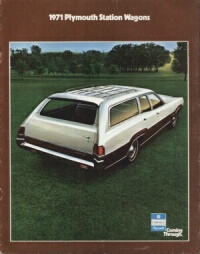
|
There was a separate Plymouth station wagon catalog in 1971. Click to see the Fury/Suburban section of it. |
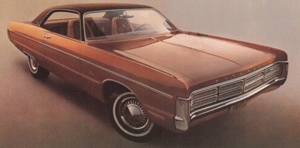
|
The 1970 Plymouth Gran Coupe special model was continued in 1971 but now the Gran Coupe was available as a real 2-door hardtop and 4-door hardtop. If ordered with four doors, it was still called the Gran Coupe. Different exterior and interior colors could be selected, but only the tan standard interior would sport a Paisley patterend upholstery. The Sport Fury grille was standard and the C-pillar featured a Gran Coupe nameplate. |
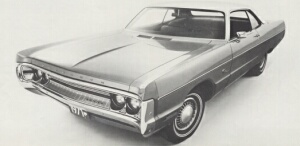
|
May of 1971 saw the introduction of a new model, the Fury Custom. It ranged between the Fury I and Fury II, came standard with some popular options and had paisley patterned black vinyl upholstery. It was available as a two-door coupe and four-door sedan. |
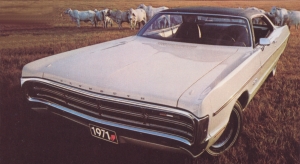
|
This photo of a 1971 Plymouth Sport Fury two-door hardtop can be found in the corporation's 1970 annual financial report. |
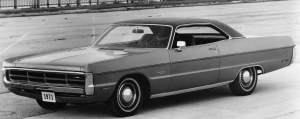
|
This press photo shows a 1971 Plymouth Sport Fury two-door hardtop with standard roof (body style). |
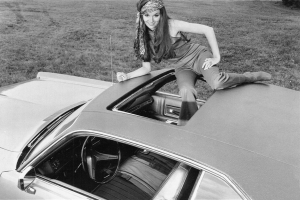
|
This press photo promotes the power sunroof that was available on 1971 Plymouth Fury two-door models for the first time this year to compensate for convertibles not being offered in the Fury line anymore. |
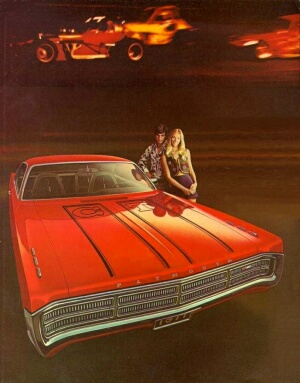
|
This is a different motif of the 1971 Plymouth Sport Fury GT than the one seen in the Fury brochure. It's probably the same car, though. |
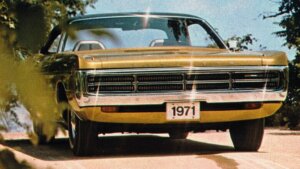
|
Read what »Popular Science« author Jim Dunne had to say about the new Fury in the Plymouth Traveler. |
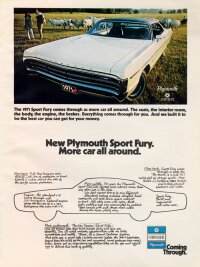
|
The same image as can be seen above was used for this Sport Fury advertisement. |
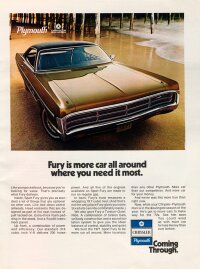
|
The same car that can be found on the Fury brochure cover starred in this advertisement for a Sport Fury. |
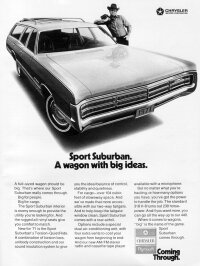
|
No reference in the copy text is made to the Cowboy leaning against the 1971 Sport Suburban. But we know why he's smiling, because, as the advertisement tells us, »when it comes to wagons, big is the name of the game«. How true! |
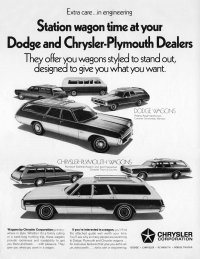
|
Here's a Chrysler Corporation ad promoting the 1971 Chrysler, Dodge and Plymouth Station Wagons. |

|
Click for the 1971 Chrysler-Plymouth passenger car Trailer Towing Guide |
 |
Click to see the list of manufacturer's suggested retail prices for the 1971 Plymouth Fury models and factory-installed options. |
|
Fuselage Home |